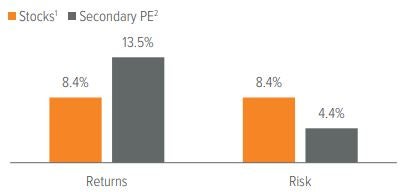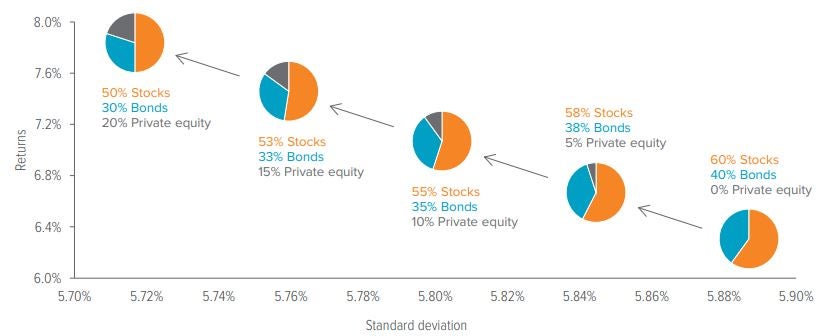
Secondary private equity can potentially enhance the return and risk profile of a traditional 60/40 portfolio.
The core investment portfolio needed to balance return and risk–long viewed by financial advisors as a prototypical 60/40 stock/bond allocation–is taking on a different look. We believe advisors are coming to the same conclusion as institutional investors: alternatives are not alternatives anymore.
Accordingly, advisors appear to be making alternatives a core component of strategic asset allocations. As a result, some investors are seeking to add private markets to portfolios to potentially achieve greater longer-term returns and mitigate risk.
A long track record of higher returns and lower risk
Secondary private equity (PE) has emerged as an alternative way to access private markets. Investors may benefit from its potential for attractive returns, modest volatility and lower correlations to other asset classes.
Over the long term, secondary private equity has delivered higher absolute and risk-adjusted returns compared to public equities (Exhibit 1).

As of 12/31/23. Source: MSCI, Bloomberg and Cambridge Associates. Past performance is no guarantee of future results. See disclosures for index definitions and other disclosures.
Historically strong downside protection
When broader market conditions deteriorate, secondary private equity investments have exhibited lower volatility and downside risk compared to public equity, and even primary private equity investments (Exhibit 2).

As of 12/31/23. Source: Pomona Capital, Capital IQ (S&P), Cambridge Associates (CA Index). Data show cumulative quarterly returns during drawdown periods from 1999 to 2023. Past performance is not an indication of future performance. There is no guarantee that an investment in a Pomona-sponsored fund will ultimately be profitable. See disclosures for index definitions and other disclosures.
Secondary PE: A potential path to more attractive risk-adjusted returns
Adding secondary private equity to a 60/40 portfolio is a possible strategy to help enhance risk-adjusted returns. As the data below illustrates, reallocating a portion of the portfolio from public equities and bonds to secondary private equity enhanced the risk-return profile of the portfolio (Exhibit 3).
By strategically incorporating secondary private equity into a traditional 60/40 allocation, advisors can seek to enhance risk-adjusted returns, diversify their holdings, and create a more balanced and resilient investment strategy for their clients’ portfolios.

As of 12/31/23. Assumptions: Portfolio with Secondary PE takes 50% of the allocation from Bonds and Stocks each. Indices used: Cambridge Associates Secondary Index; Stocks: MSCI
World Index; Bonds: Bloomberg U.S. Aggregate Bond Index.5
The above reflects an investment in the stated allocations if invested on 01/01/04 and held through 12/30/23. The data above is for hypothetical purposes and is intended to show potential returns that may be achieved based on the above investment allocations across equity, private equity, and fixed income in a particular portfolio. It Is not intended to show actual returns for each portfolio in every case. The statements made above are the opinions of Pomona Capital and are subject to change. There can be no assurance that any investment made in a Pomona fund will have any or all of the investment characteristics described herein. Prospective investors should consult their financial, tax and legal advisors prior to making a commitment to any Pomona-sponsored fund. Investments in private equity involve a substantial degree of risk; there is no guarantee that any investment in a Pomona-sponsored fund will ultimately be profitable and an investor could lose some or all of its investment. Past performance is not indicative of future results. Please read in conjunction with footnotes and disclaimers.
A note about risk
Investing in private equity is a risk and there is no guarantee that an investment in private equity or in a Pomona-sponsored fund will be profitable. The above scenarios are for illustrative purposes only and are theoretical; there is no guarantee an investment in a Pomona-sponsored fund will exhibit any of the above characteristics or return profile.
Discussed below are the investments generally made by Investment Funds and the principal risks that the Adviser and the Fund believe are associated with those investments and with direct investments in operating companies. These risks will, in turn, have an effect on the Fund. In response to adverse market, economic or political conditions, the Fund may invest in investment grade fixed income securities, money market instruments and affiliated or unaffiliated money market funds or may hold cash or cash equivalents for liquidity or defensive purposes, pending investment in longer-term opportunities. In addition, the Fund may also make these types of investments pending the investment of assets in Investment Funds and Co-Investment Opportunities or to maintain the liquidity necessary to effect repurchases of Shares. When the Fund takes a defensive position or otherwise makes these types of investments, it may not achieve its investment objective.
The value of the Fund’s total net assets is expected to fluctuate in response to fluctuations in the value of the Investment Funds, direct investments and other assets in which the Fund invests. An investment in the Fund involves a high degree of risk, including the risk that the Shareholder’s entire investment may be lost. The Fund’s performance depends upon the Adviser’s selection of Investment Funds and direct investments in operating companies, the allocation of offering proceeds thereto, and the performance of the Investment Funds, direct investments, and other assets. The Investment Funds’ investment activities and investments in operating companies involve the risks associated with private equity investments generally. Risks include adverse changes in national or international economic conditions, adverse local market conditions, the financial conditions of portfolio companies, changes in the availability or terms of financing, changes in interest rates, exchange rates, corporate tax rates and other operating expenses, environmental laws and regulations, and other governmental rules and fiscal policies, energy prices, changes in the relative popularity of certain industries or the availability of purchasers to acquire companies, and dependence on cash flow, as well as acts of God, uninsurable losses, war, terrorism, earthquakes, hurricanes or floods and other factors which are beyond the control of the Fund or the Investment Funds. Unexpected volatility or lack of liquidity, such as the general market conditions that prevailed in 2008, could impair the Fund’s performance and result in its suffering losses. The value of the Fund’s total net assets is expected to fluctuate. To the extent that the Fund’s portfolio is concentrated in securities of a single issuer or issuers in a single sector, the investment risk may be increased. The Fund’s or an Investment Fund’s use of leverage is likely to cause the Fund’s average net assets to appreciate or depreciate at a greater rate than if leverage were not used.
The Fund is a non-diversified, closed-end management investment company with limited performance history that a Shareholder can use to evaluate the Fund’s investment performance. The Fund may be unable to raise substantial capital, which could result in the Fund being unable to structure its investment portfolio as anticipated, and the returns achieved on these investments may be reduced as a result of allocating all of the Fund’s expenses over a smaller asset base. The initial operating expenses for a new fund, including start-up costs, which may be significant, may be higher than the expenses of an established fund. The Investment Funds may, in some cases, be newly organized with limited operating histories upon which to evaluate their performance. As such, the ability of the Adviser to evaluate past performance or to validate the investment strategies of such Investment Funds will be limited. In addition, the Adviser has not previously managed the assets of a closed-end registered investment company.
Closed-End Fund; Liquidity Risks: The Fund is a non-diversified closed-end management investment company designed principally for long-term investors and is not intended to be a trading vehicle. An investor should not invest in the Fund if the investor needs a liquid investment. Closed-end funds differ from open-end management investment companies (commonly known as mutual funds) in that investors in a closed-end fund do not have the right to redeem their shares on a daily basis at a price based on net asset value.
